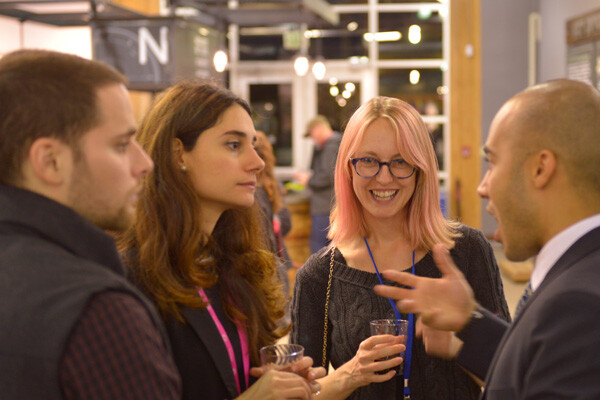The Insider’s Guide to Networking at Events

 Many people feel anxious and nervous when entering a room filled with unfamiliar faces but you no longer have to be one of those people. If you’re looking to make a career move into sustainability, corporate responsibility or the impact economy, in-person networking remains the best way to convert potential opportunities into real jobs. There is just no way around that.
Many people feel anxious and nervous when entering a room filled with unfamiliar faces but you no longer have to be one of those people. If you’re looking to make a career move into sustainability, corporate responsibility or the impact economy, in-person networking remains the best way to convert potential opportunities into real jobs. There is just no way around that.
Networking events can be great opportunities for developing new relationships and broadening business networks, plus they can be fun. Below are a few tips on how you may be able to improve your skills to “work the room.”
Preparation
Do your research! Before you even set foot in the door make sure you have looked up the list of speakers and attendees and flagged any that are of interest to you. This includes who they work for, latest press release, news, etc.
If they are a speaker, familiarize yourself with their topic as well. Going in with some background and a few talking points will give you the confidence to approach someone new. Think of at least three conversation points or topics that match the event and those attending.
If possible, email attendees you want to meet beforehand and ask for a few minutes with them at the event. Yes, this is ok and helps you stand out!
At the event
I don’t know about you but I perform at my best when I arrive early and have a chance to settle in and survey the scene before many people arrive. This will give you a chance to take a look at the seating plan and exhibitor list.
Also, don’t be afraid to take on the role of the “introducer.” Bring people together with common interests or who are working on similar issues. Since you have done your homework before hand, this shouldn’t be a problem.
Don’t feel confident? Fake it! By approach, starting conversations and acting cool in an uncomfortable situation, you will naturally begin to loosen up and realise you are actually good at it.
Meeting new people
Always be the first to say hello to new people. Say hello and greet people warmly. Waiting to be “properly” introduced may result in no introduction at all. Remember to shake hands and always smile. Don’t rush introductions - take your time and show sincerity. If it helps, use and icebreaker to jumpstart a conversation. Here area few of my favorites:
- “How did you get into the sustainability field?”
- “Why do you like working at their company name?”
- “So what is your latest project that is keeping you up at night?”
- “What do you love about your job?”
- “What impact are you trying to make?”
Plan your pitch
It’s a good idea to prepare a 30-second elevator pitch that sums up your USP – unique selling points. A killer elevator pitch is concise, clear, confident, and ends with a question or request. Practice in advance!
- Learn, remember, and use a person’s name. Repeat the name to yourself after hearing it and use it often during conversation. Using a person’s name throughout a conversation not only helps to build a personal connection with that person, but also demonstrates your caring and attentive nature.
- Before moving on to the next conversation, ask for their business card and give them yours. And it is ok to move on gracefully (see exit strategies below).
Keep the conversation going
Show an interest in others and be a good listener. Great conversationalists are set apart by their ability to make any conversational partner feel like the only person in the room. Since networking is a two way street, think of ways you may be able to help the other person. Take your time during conversations and don’t be afraid to ask follow-up questions that dig a little deeper.
Don’t dominate the conversation and don’t let others dominate it either. Try to give everyone a chance to speak in an interaction by asking “what do you think?” or “what is your opinion?”
Exit strategies
Once the time has come to leave a conversation, leave with a smile and handshake. Tell the person how much you enjoyed speaking with them and establish a way to make contact in the future.
After you leave the conversation make a mental note of the person’s name and other pertinent or interesting information that you can use when you speak with that person in the future. I usually jot down a few notes immediately on where we met, what we spoke about, and a distinguishing physical feature so that I can recall who exactly they were at a later date.
Follow up
Once the event is over you are not off the hook. Now it is time to follow-up in a timely manner.
First, update your database with your new contact within 48 hours. Then, send a follow-up email to each person you met within 24 hours referencing what you spoke about and any next steps or just to say “good to meet you.” If you had offered to help your new contact with something then follow-up on this as well as this gains many points in the future.
You already know these but some typical DON’Ts are:
- Find the one person who looks familiar and stick with that person for the duration of the event.
- Make the food table or bar your permanent home.
- Just wander the room saying hello to many different people without ever engaging in a full conversation.
- Let yourself feel stuck with one or two conversations. Feel free to move on after 3 minutes of really listening to the person you are with.
Good luck putting this thoughts into action at your next event. I’d love to hear how it goes! If you’d like some bespoke networking adivce or help on your elevator pitch, please contact me.
---
 Shannon Houde is the founder of Walk of Life Consulting, the first international career advisory business focused solely on the sustainability, social impact, international development and Corporate Responsibility (CR) fields.
Shannon Houde is the founder of Walk of Life Consulting, the first international career advisory business focused solely on the sustainability, social impact, international development and Corporate Responsibility (CR) fields.




